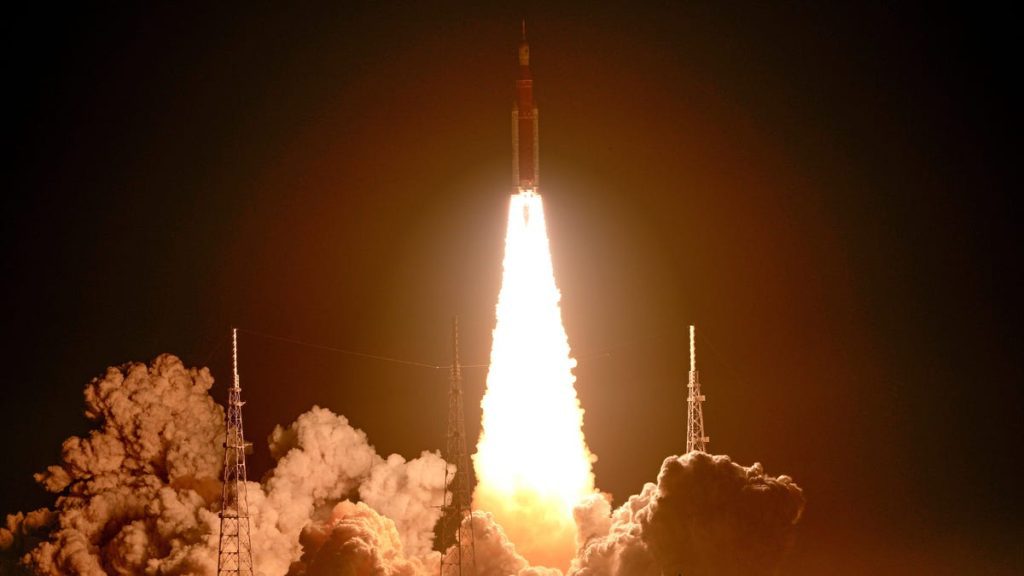Artemis 1 Successfully Launches NASA Back to the Moon After 50-Year Wait

NASA’s new moon rocket lifts off from Launch Pad 39B at the Kennedy Space Center in Cape Canaveral, FL, Wednesday, Nov. 16, 2022. Photo: John Raoux/AP Photo (AP)
The Artemis 1 mission had a successful launch on Wednesday, and NASA’s return to the moon after 50 years is finally underway. The Artemis 1’s Space Launch System (SLS) rocket and Orion lifted off from the Kennedy Space Center in Florida for the maiden voyage and crucial test flight after a series of delays that trace back to 2017, according to the Associated Press. And after having recently withstood weather conditions brought by Hurricane Nicole.
The Artemis 1 SLS rocket and Orion capsule shot into space using 8.8 million pounds of thrust from the combined core stage and boosters of the 322-foot rocket, the most powerful ever built by NASA. Two minutes into the launch, the side boosters fell away while the core stage kept firing. About 90 minutes into flight, the rocket’s upper stage fired for 18 minutes, pushing Orion out of Earth orbit and towards the moon.
Spectators watch as NASA launches new moon rocket
NASA expects Orion to reach the moon by Monday, but the Artemis 1’s journey has really just begun. The data gathered so far seems to indicate the SLS rocket boosters and engines performed well, however, NASA is still wary of what issues could arise. This is a demo, after all: a test to make sure the Artemis can safely ferry astronauts back to the lunar surface after the last Apollo mission in 1972.
If all goes well during the Artemis 1’s 25-day test flight, NASA plans to replace the three mannequins currently aboard the Orion capsule — the AP says NASA calls them “moonequins” — with four actual astronauts who could reach lunar orbit in a later mission planned for 2024. Astronauts will then return to space for a mission in 2025 to board a SpaceX Starship and land on the lunar surface.
Of course, 2025 is both a long and short time away and a lot can go either right or wrong in the next two years. In fact, a couple of issues threatened the Artemis 1 launch as recently as this week: a hydrogen fuel leak erupted on Tuesday, but an emergency team managed to contain the leak by tightening a faulty fuel valve as the rocket sat on Launch Pad 39B. And a U.S. Space Force radar went dark but the agency managed to fix it by replacing an ethernet switch, per the AP.
G/O Media may get a commission
Leaky fuel valves and ethernet switches sound like mundane problems, but these are things that can make or break a $4.1 billion test flight. The Artemis 1 had already sustained some damage when it hunkered down on its launch pad during Hurricane Nicole, but NASA approved the launch. When the leak sprung on Tuesday, it risked another possible delay but NASA was able to avoid that:
“The rocket, it’s alive. It’s creaking. It’s making venting noises. It’s pretty scary,” said Trent Annis, one of the three men who entered the blast danger zone to fix Tuesday night’s leak. “My heart was pumping. My nerves were going. But yeah, we showed up today.”
The Artemis missions are reportedly NASA’s sequel to Apollo, even having been named after the two siblings in Greek mythology. Just as Artemis was the twin sister of Apollo, the Artemis missions are NASA’s closely related efforts to those of the Apollo missions. Launch Director Charlie Blackwell-Thompson says this latest launch is “…for the Artemis generation,” which has now earned its place in history.
Photo: Terry Renna/AP Photo (AP)
Photo: Terry Renna/AP Photo (AP)



